Complex Network Analysis of Photovoltaic Plant Operations and Failure Modes
Abstract
1. Introduction
2. Methodology
- data collection and pre-processing,
- connectivity analysis and graph modeling,
- pattern recognition.
2.1. Complex Network Analysis
2.2. Exploratory Data Analysis
3. Case Study
4. Results
- A to B (from 00:00 of 20 May to 16:00 of 31 August), includes the sub-set of operating conditions of the inverter block with AC and DC voltages, and active power following the trend of actual solar irradiance.
- A’ to B’ (from 00:00 of 20 May to 16:00 of 31 August), includes the sub-set representative of night conditions.
- C to D (from 16:00 of 31 August to 18:00 of 15 September), then, represents the power system shutdown phase after the fault event following which AC and DC voltages, and active power zeroed.
- A to B (from 00:00 of 20 May to 06:30 of 31 August), typical of the standard operation, features a degree centrality in the range 3 to 2, which is nearly proportional to the diameter of the network which experience a variation in the range 3 to 1.5.
- C to D (from 16:30 of 31 August to 18:00 of 15 September), represents the fault phase with the inverter shutdown. This cluster is characterized by low values of degree centrality (i.e., below 1) and low values of the network diameter (1.5 to 0.2).
- B to C (from 06:30 to 16:30 of 31 August), finally includes the sub-set of operations that transition the inverter to fault. This cluster contains the series of points connecting the previous groups. While the network diameter ranges between 2.5 and 1.5, the degree of centralities gradually decreases from 2 to about 1 for inverter 1 block A voltages and active power. This circumstance permits us to infer that this cluster, possibly, isolates the evolution of inverter operating conditions from the precursor (6:30) to the automatic block shutdown (13:30) including also the preliminary phase of fault evolution with non-zero AC/DC voltages (16:30). As such, it demonstrates the possibility of identifying at 7 h long pre-fault event which anticipates the evolution of inverter operating conditions on 31 August.
5. Conclusions
Author Contributions
Funding
Conflicts of Interest
References
- Lacal Arantegui, R.; Jäger-Waldau, A. Photovoltaics and wind status in the European Union after the Paris Agreement. Renew. Sustain. Energy Rev. 2018, 81, 2460–2471. [Google Scholar] [CrossRef]
- Antonelli, M.; Desideri, U. The doping effect of Italian feed-in tariffs on the PV market. Energy Policy 2014, 67, 583–594. [Google Scholar] [CrossRef]
- Moreno-Garcia, I.M.; Palacios-Garcia, E.J.; Pallares-Lopez, V.; Santiago, I.; Gonzalez-Redondo, M.J.; Varo-Martinez, M.; Real-Calvo, R.J. Real-Time Monitoring System for a Utility-Scale Photovoltaic Power Plant. Sensors 2016, 16, 770. [Google Scholar] [CrossRef] [PubMed]
- Mellit, A.; Tina, G.M.; Kalogirou, S.A. Fault detection and diagnosis methods for photovoltaic systems: A review. Renew. Sustain. Energy Rev. 2018, 91, 1–17. [Google Scholar] [CrossRef]
- Richter, M.; Tjengdrawira, C.; Vedde, J.; Green, M.; Frearson, L.; Herteleer, B.; Jahn, U.; Herz, M.; Kontges, M.; Stridh, B.; et al. Technical Assumptions Used in PV Financial Models Review of Current Practices and Recommendations; Report IEA-PVPS T13-08:2017; IEA: Paris, France, 2017. [Google Scholar]
- Houssein, A.; Heraud, N.; Souleiman, I.; Pellet, G. Monitoring and fault diagnosis of photovoltaic panels. In Proceedings of the IEEE International Energy Conference and Exhibition, Manama, Bahrain, 18–22 December 2010; pp. 389–394. [Google Scholar]
- Spagnuolo, G.; Xiao, W.; Cecati, C. Monitoring, Diagnosis, Prognosis, and Techniques for Increasing the Lifetime/Reliability of Photovoltaic Systems. IEEE Trans. Ind. Electron. 2015, 62, 7226–7227. [Google Scholar] [CrossRef]
- Muhammad, N.; Zakaria, N.Z.; Shaari, S.; Omar, A.M. Fault detection approach in photovoltaic system using Mathematical method diagnosis. J. Fundam. Appl. Sci. 2018, 10, 270–281. [Google Scholar]
- Davarifar, M.; Rabhi, A.; Elhajjaji, A.; Dahmane, M. Real-time Model base Fault Diagnosis of Photovoltaic Panels Using Statistical Signal Processing. In Proceedings of the International Conference on Renewable Energy Research and Applications, Madrid, Spain, 20–23 October 2013; pp. 599–604. [Google Scholar]
- Hassan Ali, M.; Rabhi, A.; Elhajjaji, A.; Tina, G.M. Real Time Fault Detection in Photovoltaic Systems. Energy Procedia 2017, 111, 914–923. [Google Scholar]
- Chen, Y.H.; Liang, R.; Tian, Y.; Wang, F. A novel fault diagnosis method of PV based-on power loss and I-V characteristics. IOP Conf. Ser. Earth Environ. Sci. 2016, 40, 012022. [Google Scholar] [CrossRef]
- Garoudja, E.; Harrou, F.; Sun, Y.; Kara, K.; Chouder, A.; Silvestre, S. Statistical fault detection in photovoltaic systems. Sol. Energy 2017, 150, 485–499. [Google Scholar] [CrossRef]
- Chiacchio, F.; Famoso, F.; D’Urso, D.; Brusca, S.; Aizpurua, J.I.; Cedola, L. Dynamic Performance Evaluation of Photovoltaic Power Plant by Stochastic Hybrid Fault Tree Automaton Model. Energies 2018, 11, 306. [Google Scholar] [CrossRef]
- Dhimish, M.; Holmes, V.; Mehrdadi, B.; Dales, M. Multi-layer photovoltaic fault detection algorithm. High Volt. 2017, 2, 244–252. [Google Scholar] [CrossRef]
- Bonsignore, L.; Davarifar, M.; Rabhi, A.; Tina, G.M.; Elhajjaji, A. Neuro-Fuzzy fault detection method for photovoltaic systems. Energy Procedia 2014, 62, 431–441. [Google Scholar] [CrossRef]
- Ventura, C.; Tina, G.M. Development of models for on-line diagnostic and energy assessment analysis of PV power plants: The study case of 1 MW Sicilian PV plant. Energy Procedia 2015, 83, 248–257. [Google Scholar] [CrossRef]
- Abdulmawjood, K.; Refaat, S.S.; Morsi, W.G. Detection and prediction of faults in photovoltaic arrays: A review. In Proceedings of the IEEE 12th International Conference on Compatibility, Power Electronics and Power Engineering, Doha, Qatar, 10–12 April 2018; pp. 1–8. [Google Scholar]
- Chokor, A.; El Asmar, M.; Lokanath, S.V. A Review of Photovoltaic DC Systems Prognostics and Health Management: Challenges and Opportunities. In Proceedings of the Annual Conference of the Prognostics and Health Management Society, Denver, CO, USA, 3–6 October 2016; pp. 43–54. [Google Scholar]
- Triki-Lahiani, A.; Bennani-Ben Abdelghani, A.; Slama-Belkhodja, I. Fault detection and monitoring systems for photovoltaic installations: A review. Renew. Sustain. Energy Rev. 2018, 82, 2680–2692. [Google Scholar] [CrossRef]
- Gubbi, J.; Buyya, R.; Marusic, S.; Palaniswami, M. Internet of Things (IoT): A vision, architectural elements, and future directions. Future Gener. Comput. Syst. 2013, 29, 1645–1660. [Google Scholar] [CrossRef]
- Macaluso, I.; Galiotto, C.; Marchetti, N.; Doyle, L. A complex systems science perspective on wireless networks. J. Syst. Sci. Complex. 2016, 29, 1034–1056. [Google Scholar] [CrossRef]
- Corsini, A.; Bonacina, F.; Feudo, S.; Marchegiani, A.; Venturini, P. Internal Combustion Engine sensor network analysis using graph modeling. Energy Procedia 2017, 126, 907–914. [Google Scholar] [CrossRef]
- Zhou, K.; Fu, C.; Yang, S. Big data driven smart energy management: From big data to big insights. Renew. Sustain. Energy Rev. 2016, 56, 215–225. [Google Scholar] [CrossRef]
- Yu, N.; Shah, S.; Johnson, R.; Sherick, R.; Hong, M.; Loparo, K. Big Data Analytics in Power Distribution Systems. In Proceedings of the IEEE Power & Energy Society Innovative Smart Grid Technologies Conference, Washington, DC, USA, 18–20 February 2015; pp. 1–5. [Google Scholar]
- Daliento, S.; Chouder, A.; Guerriero, P.; Massi Pavan, A.; Mellit, A.; Moeini, R.; Tricoli, P. Monitoring, Diagnosis, and Power Forecasting for Photovoltaic Fields: A Review. Int. J. Photoenergy 2017, 2017, 1356851. [Google Scholar] [CrossRef]
- Riley, D.; Johnson, J. Photovoltaic Prognostics and Heath Management using Learning Algorithms. In Proceedings of the 38th IEEE Photovoltaic Specialists Conference, Austin, TX, USA, 3–8 June 2012; pp. 1535–1539. [Google Scholar]
- Chine, W.; Mellit, A.; Bouhedir, R. FPGA-Based Implementation of an Intelligent Fault Diagnosis Method for Photovoltaic Arrays. In Artificial Intelligence in Renewable Energetic Systems; Springer: Cham, Switzerland, 2018; pp. 245–252. [Google Scholar]
- De Benedetti, M.; Leonardi, F.; Messina, F.; Santoro, C.; Vasilakos, A. Anomaly detection and predictive maintenance for photovoltaic systems. Neurocomputing 2018, 310, 59–68. [Google Scholar] [CrossRef]
- Jiang, L.L.; Maskell, D.L. Automatic Fault Detection and Diagnosis for Photovoltaic Systems using Combined Artificial Neural Network and Analytical Based Methods. In Proceedings of the IEEE International Joint Conference on Neural Networks, Killarney, Ireland, 12–17 July 2015; pp. 1–8. [Google Scholar]
- Mohamed, A.H.; Nassar, A.M. New Algorithm for Fault Diagnosis of Photovoltaic Energy Systems. Int. J. Comput. Appl. 2015, 114, 26–31. [Google Scholar] [CrossRef]
- Waltz, E.; Llinas, J. Multisensor Data Fusion; Artech House: Boston, MA, USA, 1990; Volume 685. [Google Scholar]
- Newman, M.E.J. The Structure and Function of Complex Network. Siam Rev. 2003, 45, 167–256. [Google Scholar] [CrossRef]
- Kauffman, S.A. The Origins of Order: Self-Organization and Selection in Evolution; Oxford University Press: New York, NY, USA, 1993. [Google Scholar]
- Asbjørnsen, O.A. Systems Engineering Principles and Practice; SKARPODD Co.: Arnold, MD, USA, 1992. [Google Scholar]
- Pestov, I.; Verga, S. Dynamical networks as a tool for system analysis and exploration. In Proceedings of the IEEE Symposium on Computational Intelligence for Security and Defense Applications, Ottawa, ON, Canada, 8–10 July 2009; pp. 1–8. [Google Scholar]
- Carbone, A.; Jensen, M.; Sato, A.H. Challenges in data science: A complex systems perspective. Chaos Solitons Fractals 2016, 90, 1–7. [Google Scholar] [CrossRef]
- Python Version 3.5.6, 2018. Available online: http://www.python.org (accessed on 15 October 2018).
- Pedregosa, F.; Varoquaux, G.; Gramfort, A.; Michel, V.; Thirion, B.; Grisel, O.; Blondel, M.; Prettenhofer, P.; Weiss, R.; Dubourg, V.; et al. Scikit-learn: Machine learning in Python. J. Mach. Learn. Res. 2011, 12, 2825–2830. [Google Scholar]
- Hagberg, A.A.; Swart, P.J.; Schult, D.A. Exploring Network Structure, Dynamics, and Function using NetworkX. In Proceedings of the 7th Python in Science Conference, Pasadena, CA, USA, 19–24 August 2008; pp. 11–16. [Google Scholar]
- Stögbauer, H.; Grassberger, P.; Kraskov, A. Estimating Mutual Information. Phys. Rev. E 2004, 69, 066138. [Google Scholar]
- Kraskov, A. Synchronization and Interdependence Measures and their Applications to the Electroencephalogram of Epilepsy Patients and Clustering of Data. Ph.D. Thesis, John von Neumann Institute for Computing (NIC) Series, Jülich, Germany, 2004. [Google Scholar]
- Mason, S.P.; Barabási, A.L.; Oltvai, Z.N.; Jeong, H. Lethality and centrality in protein networks. Nature 2001, 411, 2–41. [Google Scholar]
- Kern, A.D.; Hahn, M.W. Comparative genomics of centrality and essentiality in three eukaryotic protein-interaction networks. Mol. Biol. Evol. 2005, 22, 803–806. [Google Scholar]
- Wibral, M.; Lindner, M.; Pipa, G.; Vicente, R. Transfer entropy—a model-free measure of effective connectivity for the neurosciences. J. Comput. Neurosci. 2011, 30, 45–67. [Google Scholar]
- Quiroga, R.Q.; Bhattacharya, J.; Pereda, E. Nonlinear multivariate analysis of neurophysiological signals. Prog. Neurobiol. 2005, 77, 1–37. [Google Scholar]
- Guye, M.; Bettus, G.; Bartolomei, F.; Cozzone, P.J. Graph theoretical analysis of structural and functional connectivity MRI in normal and pathological brain networks. Magn. Reson. Mater. Phys. Biol. Med. 2010, 23, 409. [Google Scholar] [CrossRef]
- Freeman, L.C. Centrality in social networks: Conceptual clarification. Soc. Netw. 1979, 1, 39–215. [Google Scholar] [CrossRef]
- Sànchez-Hernàndez, G.; Casabayò, M.; Agell, N.; Puigbò, J.Y. Influencer detection approaches in social networks: A current state-of-the-art. Front. Artif. Intell. Appl. 2014, 269, 261–264. [Google Scholar]
- Hacid, H.; Favre, C.; Zighed, D.A.; Guille, A. Information diffusion in online social networks: A survey. Acm Sigmod Rec. 2013, 42, 17–28. [Google Scholar]
- Granger, C.W.J. Testing for causality: A personal viewpoint. J. Econ. Dyn. Control 1980, 2, 329–352. [Google Scholar] [CrossRef]
- Scardoni, G.; Laudanna, C. Centralities Based Analysis of Complex Networks. New Front. Graph Theory 2012, 323–348. [Google Scholar] [CrossRef]
- Das, K.C.; Maden, A.D.G.; Cangul, I.N.; Cevik, A.S. On Average Eccentricity of Graphs. Proc. Natl. Acad. Sci. India Sect. A Phys. Sci. 2017, 87, 23–30. [Google Scholar] [CrossRef]
- Koschützki, D.; Schreiber, F. Centrality Analysis Methods for Biological Networks and Their Application to Gene Regulatory Networks. Gene Regul. Syst. Biol. 2008, 2, 193–201. [Google Scholar] [CrossRef]
- Tamassia, R.; Tollis, I.G.; Di Battista, G.; Eades, P. Graph Drawing: Algorithms for the Visualization of Graphs; Prentice Hall: Upper Saddle River, NJ, USA, 1998. [Google Scholar]
- Tukey, J.W. The Future of Data Analysis. Ann. Math. Stat. 1962, 33, 1–67. [Google Scholar] [CrossRef]
- Yu, C.H. Exploratory data analysis in the context of data mining and resampling. Int. J. Psychol. Res. 2010, 3, 9–22. [Google Scholar] [CrossRef]
- Seltman, H.J. Experimental Design and Analysis; Carnegie Mellon University: Pittsburgh, PA, USA, 2012. [Google Scholar]
- Ho, T.K.; Basu, M.; Law, M.H.C. Data Complexity in Pattern Recognition; Springer Science & Business Media: Berlin, Germany, 2006. [Google Scholar]
- Camacho, J.; Pérez-Villegas, A.; Rodríguez-Gómez, R.A.; Jiménez-Mañas, E. Multivariate Exploratory Data Analysis (MEDA) Toolbox for Matlab. Chemom. Intell. Lab. Syst. 2015, 143, 49–57. [Google Scholar] [CrossRef]
- Komorowski, M.; Marshall, D.C.; Salciccioli, J.D.; Crutain, Y. Exploratory Data Analysis. Secondary Analysis of Electronic Health Records; Springer: Cham, Switzerland, 2016; pp. 185–203. [Google Scholar]
- Korn, B.; Dohler, H. A System is More Than the Sum of Its Parts—Conclusion of DLR’S Enhanced Vision Project ADVISE-PRO. In Proceedings of the 25th AIAA/IEEE Digital Avionics Systems Conference, Portland, OR, USA, 15–19 October 2006; pp. 1–8. [Google Scholar]
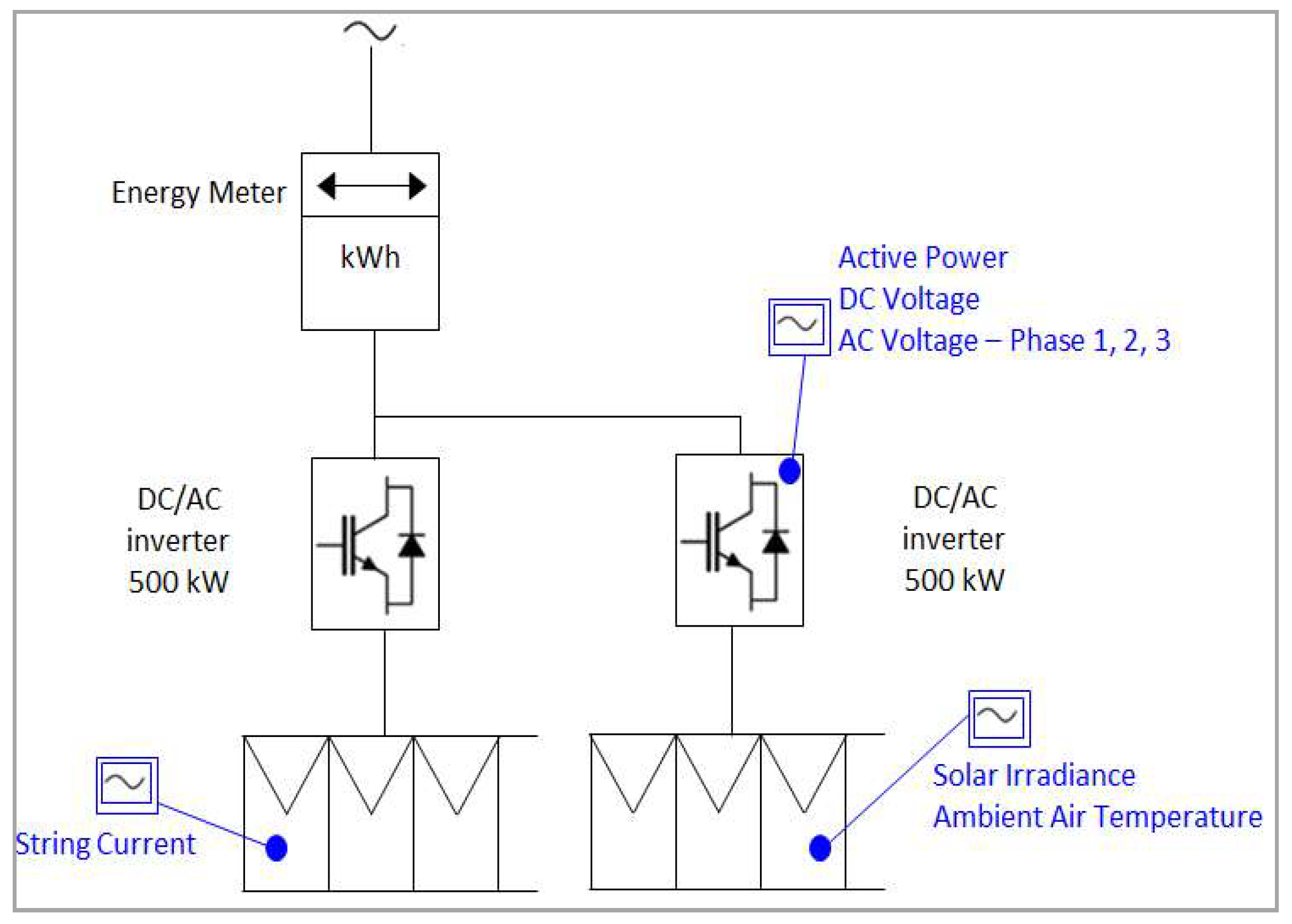
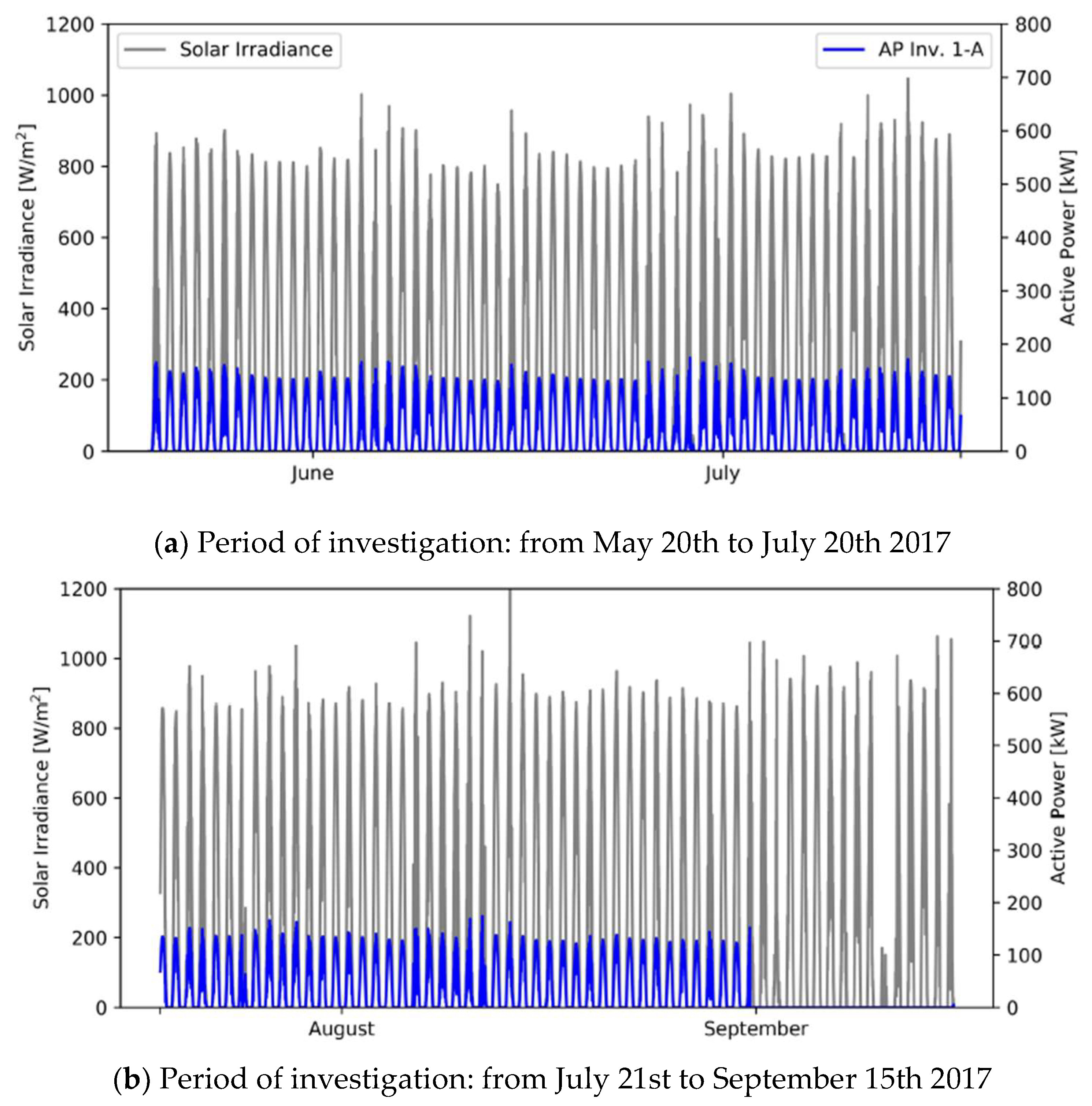
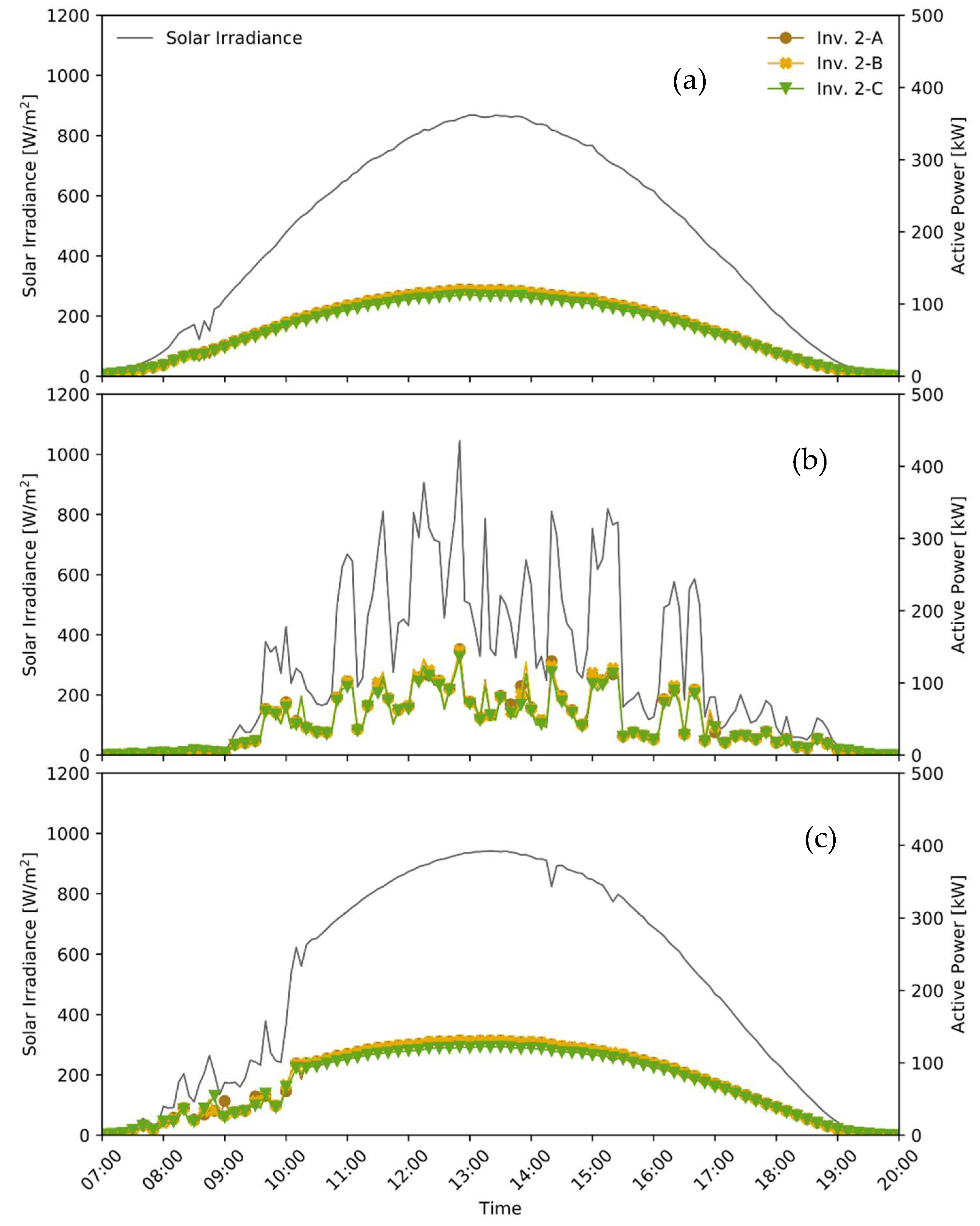
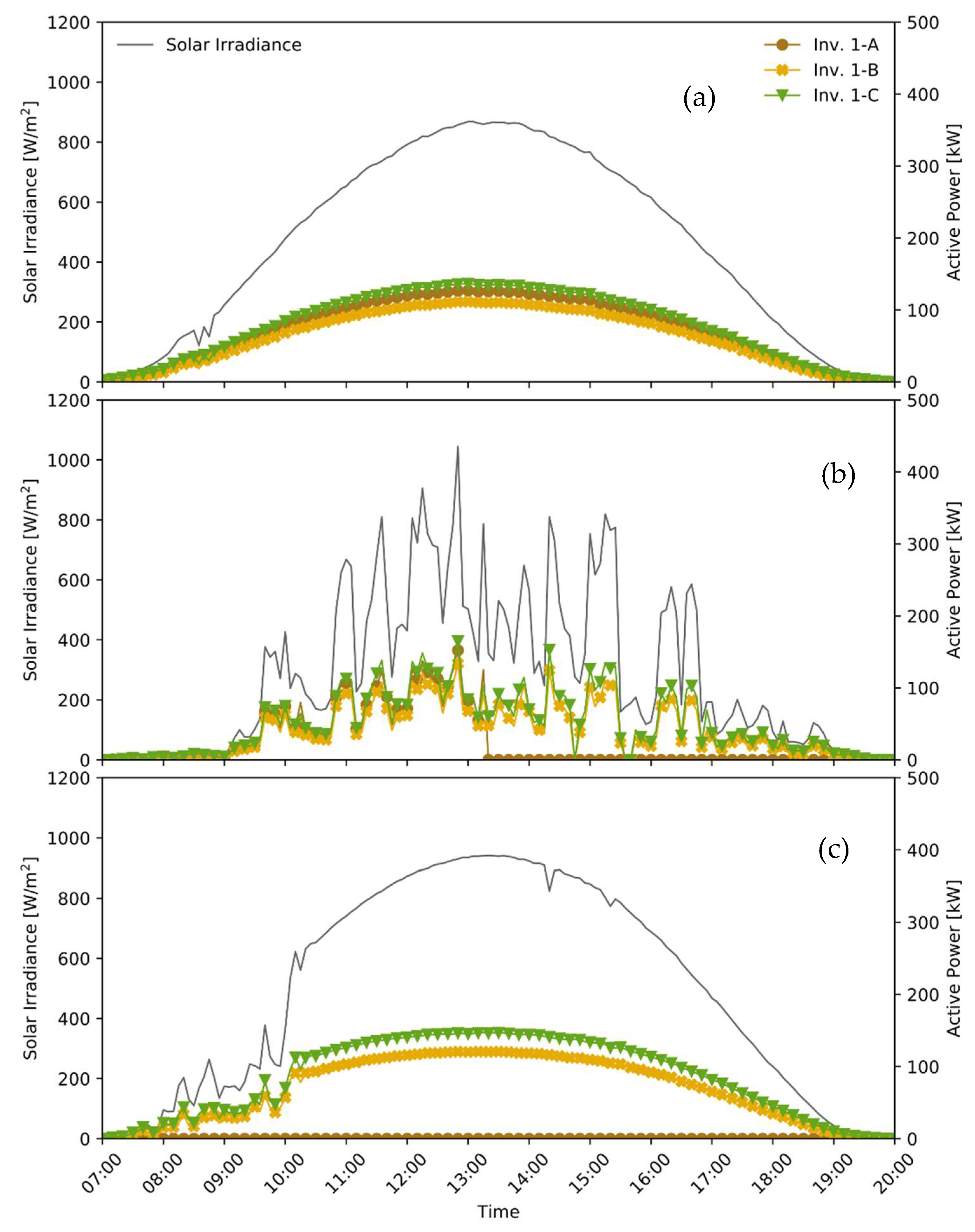
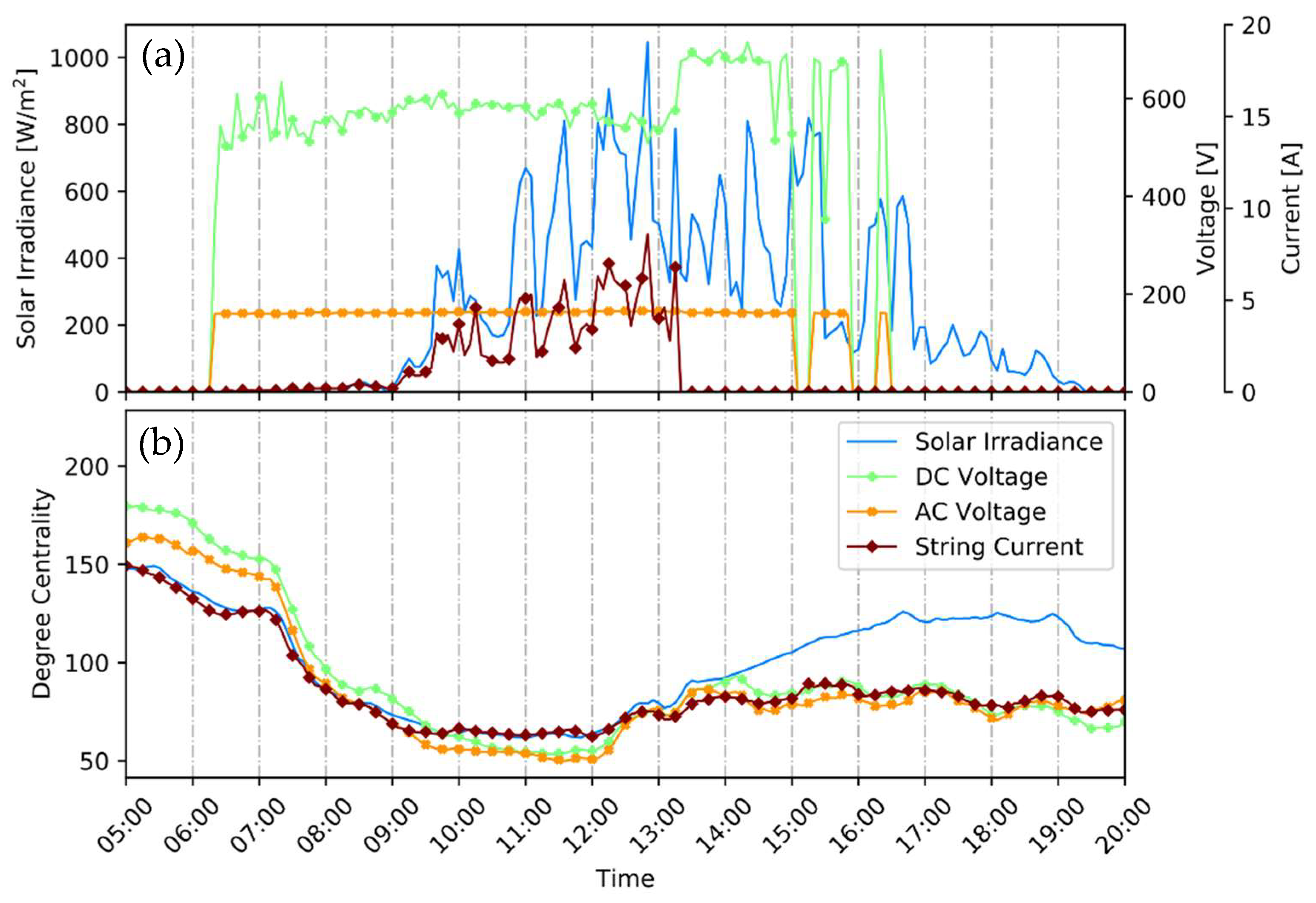
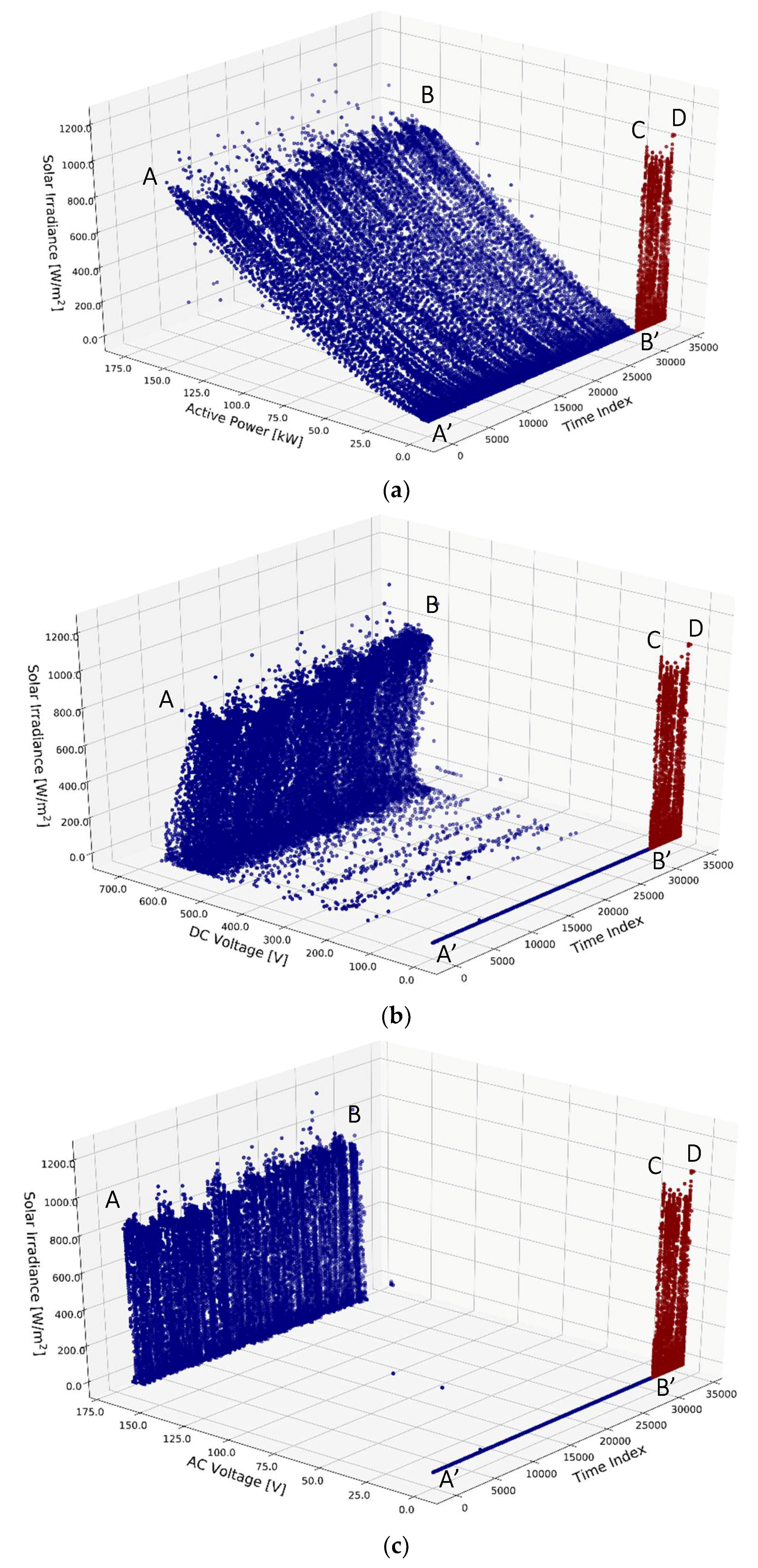
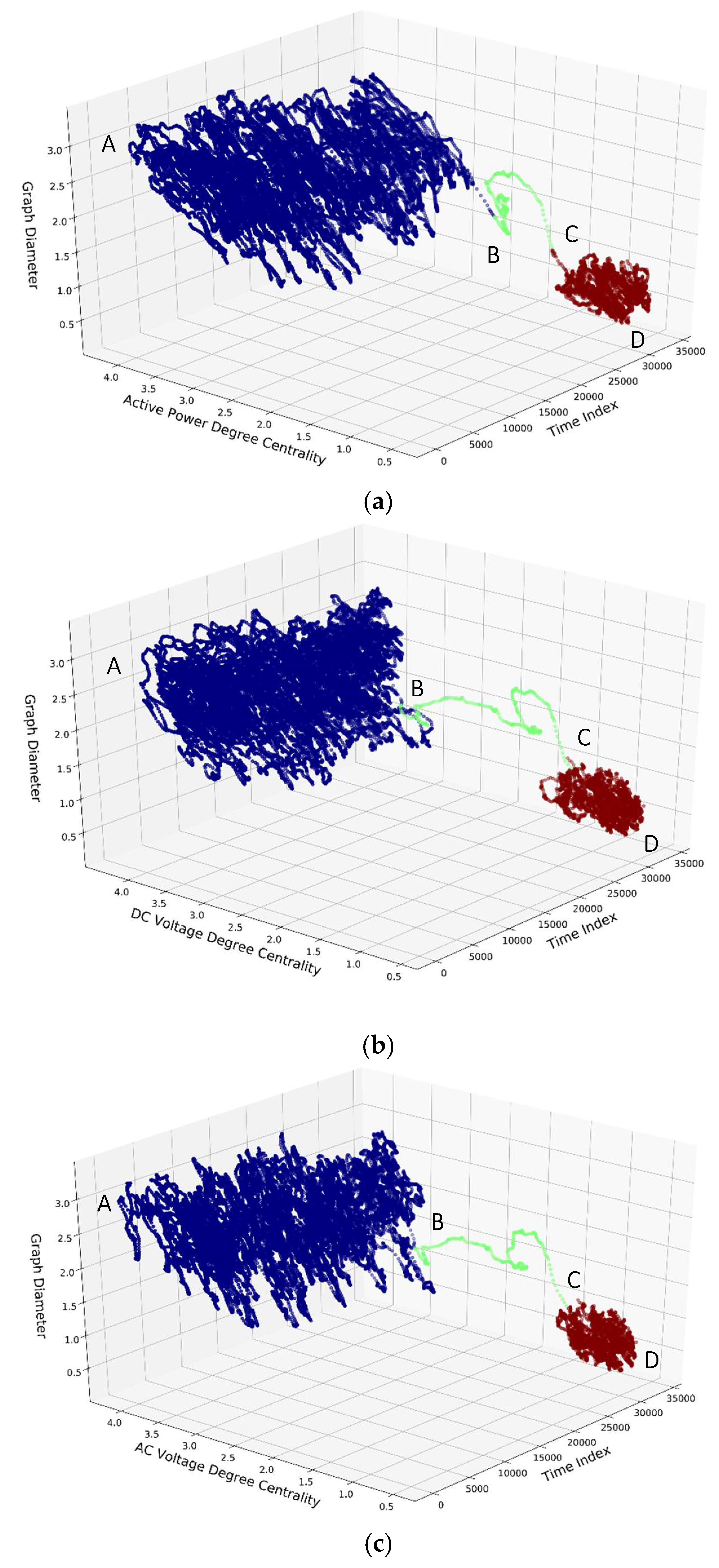
| Yn,1–16 | Variable | Yn,17–47 | Variable |
|---|---|---|---|
| 1 | DC Total Output Power [kW] | 17 | DC Voltage Inv. 1—block C [V] |
| 2 | AC Total Active Output Power [kW] | 18,19,20 | AC Voltage-phase 1, 2, 3 Inv. 1—block C [V] |
| 3 | Total PV Plant Energy Produced [kWh] | 21 | Active Output Power Inv. 2—block A [kW] |
| 4 | Ambient Air Temperature [°C] | 22 | DC Voltage Inv. 2—block A [V] |
| 5 | Solar Irradiance [W/m2] | 23,24,25 | AC Voltage-phase 1, 2, 3 Inv. 2—block A [V] |
| 6 | Active Output Power Inv. 1—block A [kW] | 26 | Active Output Power Inv. 2—block B [kW] |
| 7 | DC Voltage Inv. 1—block A [V] | 27 | DC Voltage Inv. 2—block B [V] |
| 8,9,10 | AC Voltage-phase 1, 2, 3 Inv. 1—block A [V] | 28,29,30 | AC Voltage-phase 1,2,3 Inv. 2—block B [V] |
| 11 | Active Output Power Inv. 1—block B [kW] | 31 | Active Output Power Inv. 2—block C [kW] |
| 12 | DC Voltage Inv. 1—block B [V] | 32 | DC Voltage Inv. 2—block C [V] |
| 13,14,15 | AC Voltage-phase 1, 2, 3 Inv. 1—block B [V] | 33,34,35 | AC Voltage-phase 1, 2, 3 Inv. 2—block C [V] |
| 16 | Active Output Power Inv. 1—block C [kW] | 36–47 | String currents [A] |
| Sensor | Type | Measurement Range | Temperature Range |
|---|---|---|---|
| Solar radiation sensor | Pyranometer | 0 to 4000 W/m2 | −20 to + 50 °C |
| Temperature sensor | RTD (PT-100) | −50 to + 300 °C | −50 to + 300 °C |
| Current sensors | Shunt resistor | 15 A | −40 to + 125 °C |
| Voltage sensors | Resistive potential divider | 3 to 500 V (DC) | −40 to + 85 °C |
© 2019 by the authors. Licensee MDPI, Basel, Switzerland. This article is an open access article distributed under the terms and conditions of the Creative Commons Attribution (CC BY) license (http://creativecommons.org/licenses/by/4.0/).
Share and Cite
Bonacina, F.; Corsini, A.; Cardillo, L.; Lucchetta, F. Complex Network Analysis of Photovoltaic Plant Operations and Failure Modes. Energies 2019, 12, 1995. https://doi.org/10.3390/en12101995
Bonacina F, Corsini A, Cardillo L, Lucchetta F. Complex Network Analysis of Photovoltaic Plant Operations and Failure Modes. Energies. 2019; 12(10):1995. https://doi.org/10.3390/en12101995
Chicago/Turabian StyleBonacina, Fabrizio, Alessandro Corsini, Lucio Cardillo, and Francesca Lucchetta. 2019. "Complex Network Analysis of Photovoltaic Plant Operations and Failure Modes" Energies 12, no. 10: 1995. https://doi.org/10.3390/en12101995
APA StyleBonacina, F., Corsini, A., Cardillo, L., & Lucchetta, F. (2019). Complex Network Analysis of Photovoltaic Plant Operations and Failure Modes. Energies, 12(10), 1995. https://doi.org/10.3390/en12101995






